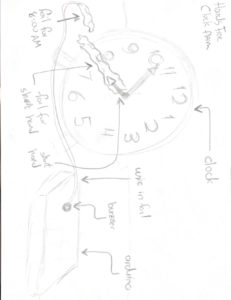concept:
During this week’s assignment, we were required to use Arduino by experimenting with a way to construct a hands-free switch (one that does not require an included analog/digital switch). Approaching this assignment, I had intentions of utilizing the Arduino in a way that would be beneficial.
code:
// Define pin for buzzer
const int buzzerPin = 9;
// Define alarm time in hours and minutes
const int alarmHour = 7;
const int alarmMinute = 30;
void setup() {
// Set the buzzer pin as an output
pinMode(buzzerPin, OUTPUT);
}
void loop() {
// Get the current time
int currentHour = hour();
int currentMinute = minute();
// Check if it is time for the alarm
if (currentHour == alarmHour && currentMinute == alarmMinute) {
// Turn on the buzzer
digitalWrite(buzzerPin, HIGH);
delay(1000);
// Turn off the buzzer
digitalWrite(buzzerPin, LOW);
delay(1000);
}
}
method:
Throughout the 12th week of the semester, another Interactive Media course, Communication and Technology, required us to experiment with going through a digital detox. As a result, I faced the issue of not being able to wake myself up since I ultimately pushed my phone away from me. That being said, I found this assignment perfect as I could make my own digital clock while also including the “hands-free” concept. The hands-free aspect was to add foil to an alarm clock’s hour hand to recognize when it hits a specific hour. This is displayed in the illustration below. To further utilize this, I adapted a simple alarm clock script that exerts a sound as soon as the signal is detected, requiring the person to wake up and pull the foil until they have to place it on again before sleeping.
sketch:
The hands-free element is when the hour arm of the clock moves to 8:00AM and eventually makes contact with the other foil piece that houses the wire connected to the Arduino, further turning on the buzzer.
future improvements:
Possibly present an element that would automatically replace the foil after it is removed to prevent further redundancy.

